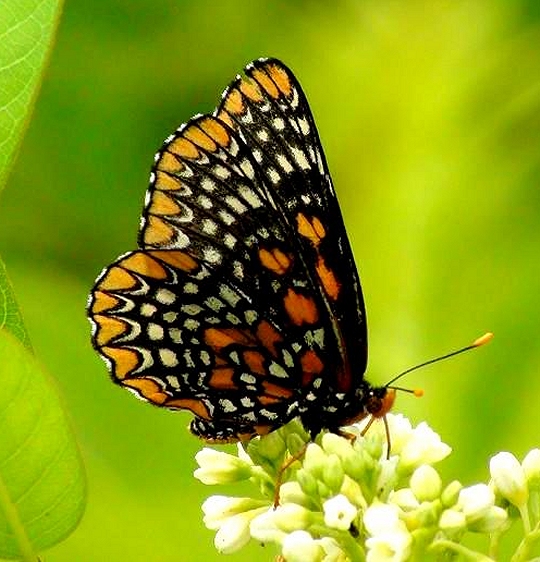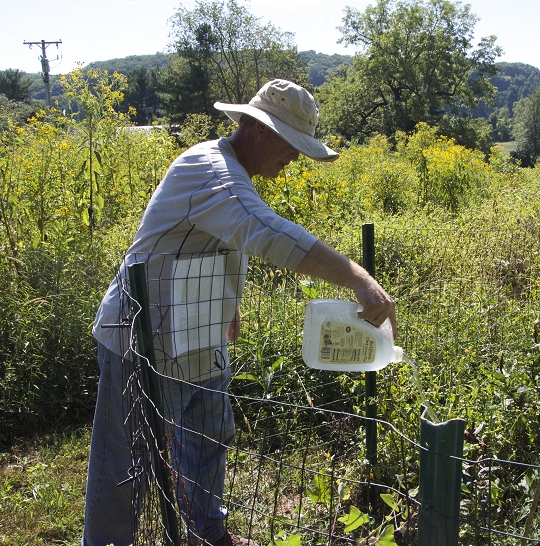 A Baltimore checkerspot butterfly on a white turtlehead plant. (Photo courtesy of Matt Perry)
A Baltimore checkerspot butterfly on a white turtlehead plant. (Photo courtesy of Matt Perry)ANNAPOLIS (Sept. 23, 2016)—When Wayne Skinner started volunteering at Cromwell Valley Park in Baltimore County five years ago, he expected to see orange-and-black-spotted Baltimore checkerspot butterflies flying around the park.
"I really thought that they were here, they were just looking for places to call home, and then I found out they're probably not here," he said.
The Baltimore checkerspot butterfly—Maryland's state insect—hasn't just disappeared from Cromwell Valley Park.
When the butterfly was named the state insect in 1973, it could be found in most parts of Maryland. Now, only about 11 colonies of this butterfly are known in the state—in Garrett, Allegany, Washington, Frederick, Carroll, Baltimore and Montgomery counties—according to the Maryland Department of Natural Resources.
"There are some sites that historically had Baltimore checkerspots that are just not there anymore," said Jennifer Selfridge, invertebrate ecologist at the Maryland Department of Natural Resources. "They're parking lots or shopping malls or they've just grown in."
The butterfly feeds on the white turtlehead plant, which thrives in wetlands and northern or mountainous regions, said Selfridge.
"If you lose the host plant, you lose the butterfly," she said. "That all happens when you lose the habitat."
The butterfly population might also be dwindling because of climate change, Selfridge said. While the Baltimore checkerspot is rare in Maryland, it does "really well" in places with cooler climates, like Canada, she explained.
Selfridge started the Baltimore Checkerspot Recovery Team in 2012 to consolidate statewide efforts to reintroduce the butterfly and improve existing habitats. The team's 18 member organizations—most in Maryland but some from out-of-state—work to establish butterfly colonies, remove invasive species from wetlands and care for existing white turtlehead plants.
At Cromwell Valley Park—a member of the recovery team—volunteers have planted four white turtlehead enclosures with high fences to protect the plants from deer. Skinner regularly drags gallons of water to these patches in an attempt to replicate the wetlands the plants are accustomed to.
However, the state of Maryland owns the park and leases the property to Baltimore County, which is engaged in a reforestation project in the park. The county has taken over 28 acres and is planning to plant trees in the area, said Skinner.
"A lot of wildlife depends on fields, whether that be butterflies or birds or groundhogs, and we're concerned now that they're just not making a real smart decision," he said. "Here I am putting this in, but are they going to take it out and put trees in it? They're trying to do one thing but they're hurting something else, and I just don't like the idea."
Don Outen, the natural resources manager for Baltimore County, said he didn't think the reforestation project was "a major issue at all."
"They have a lot of land, you know, the park was acquired over the years through different funding sources and the interest is in contributing to the restoration of the county's canopy goal," he said.
The vanEngelsdorp Bee Lab at the University of Maryland in College Park hopes to eventually provide Baltimore checkerspot larvae to other members of the recovery team, said Dennis vanEngelsdorp, the project director for the Bee Informed Partnership.
"We want to do this really well so that we don't just have this project for the sake of it, but really do establish a habitat that's going to maintain a population," he said.
The lab was able to purchase white turtlehead plants and fences thanks to grants and a campaign in 2015 that raised more than $5,000 for the effort, and has planted more than 2,000 plants on campus, but they won't be ready to host the butterfly for another two or three years.
"Doing things in very sequential, logical ways is frustrating because it's slow, but it's responsible because that's the way we're sure that what we're going to do is going to be sustainable in the long term," he said.
In the next year, Selfridge will examine population distributions of the butterfly and ensure the existing colonies in the state are stable, she said.
"Our immediate goals are just kind of to figure out where they are on the landscape and to evaluate the habitat, and that means doing some minor habitat enhancement, so we might plant plants, or do invasive species removal," she said.
The long-term goal is to create self-sustaining butterfly populations that don't require constant habitat enhancement efforts, she said.
"(The butterfly) is rare and it is declining but it's not so far gone that it requires a ton of work," Selfridge said. "Some species are just so rare, you're lucky if you have maybe one or two populations and generations."
 Wayne Skinner, a volunteer at Cromwell Valley Park in Baltimore County, waters the park's white turtlehead plants. (Photo: Hannah Lang, 14-SEP-2016)
Wayne Skinner, a volunteer at Cromwell Valley Park in Baltimore County, waters the park's white turtlehead plants. (Photo: Hannah Lang, 14-SEP-2016)

